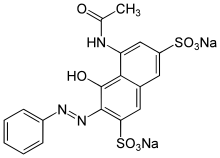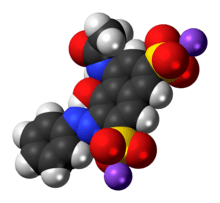Red 2G
 | |
 | |
| Names | |
|---|---|
| Other names
Acid Red 1 Food Red 10 Amidonaphthol red G azogeranine azophloxine azofloxin C.I. 18050 | |
| Identifiers | |
3D model (JSmol) |
|
| ChemSpider | |
| ECHA InfoCard | 100.020.999 |
| E number | E128 (colours) |
PubChem CID |
|
| |
| |
| Properties | |
| C18H13N3O8S2 | |
| Molar mass | 463.44 g·mol−1 |
| 18 g/100 mL (20 °C) | |
| Solubility | 1 g/ 100 mL glycerol Negligible in ethanol |
Except where otherwise noted, data are given for materials in their standard state (at 25 °C [77 °F], 100 kPa). | |
| Infobox references | |
Red 2G is a synthetic red azo dye. It is soluble in water and slightly soluble in glycerol. It usually comes as a disodium salt of 8-acetamido-1-hydroxy-2-phenylazonaphthalene-3,6 disulfonate.
Uses
Food dye
In the European Union, Red 2G was used as a food dye (E number E128). However, it was only permitted for use in breakfast sausages with a minimum cereal content of 6% and burger meat with a minimum vegetable and/or cereal content of 4%.[1]
Following safety concerns raised by EFSA in its opinion of 5 July 2007,[2] the European Commission has prepared a draft Regulation to suspend use of E128 as a food colouring. This proposed course of action was unanimously approved by European Union Member States at a meeting of the Standing Committee of the Food Chain and Animal Health (Section Toxicological Safety of the Food Chain) on 20 July 2007.[3] and Commission Regulation (EC) No 884/2007 .[4] on emergency measures suspending the use of E 128 Red 2G as food colour was published in the Official Journal of the European Union on 27 July 2007.
Red 2G is also banned in Australia, Canada, Japan, Norway,[5] and Malaysia.[6] It was banned in Israel in July 2007 .
It is relatively insensitive to the bleaching effect of sulfur dioxide (E220) and sodium metabisulfite (E223). In the intestines, Red 2G can be converted to the toxic compound aniline,[7] so there are concerns Red 2G may ultimately interfere with blood haemoglobin, as well as cause cancer.
Inks
It is also used as a dye for coatings, inks, paper, crepe paper, and fine tissue.
Histology
Red 2G can be also used for staining in histology, though rarely, e.g. as a component of Masson's trichrome.
Potential health risks
In July 2007, the EFSA established that E128 is potentially carcinogenic because it forms aniline in the body when consumed.[8] The pressure group, The Food Commission, said there had been concerns about Red 2G going back decades and it was suspected of being a carcinogen in the 1980s.[9]
References
- ↑ "European Parliament and council directive 94/36/EC of june 1994 on colours for use in foodstuffs" (PDF).
- ↑ "EFSA re-evaluates safety of food colours and adopts first opinion: Food colour Red 2G raises potential safety concerns". 9 July 2007.
- ↑ "Novel Food and Toxicological Safety - Food Safety - European Commission" (PDF). Food Safety.
- ↑ http://eur-lex.europa.eu/LexUriServ/LexUriServ.do?uri=OJ:L:2007:195:0008:0009:EN:PDF
- ↑ "Mattilsynet".
- ↑ "Dye used in burgers and sausages banned".
- ↑ Hickman, Martin (10 July 2007). "Additive used in sausages and burgers may cause cancer". The Independent. London. Archived from the original on 2008-05-22. Retrieved 22 May 2010.
- ↑ "Sausage additive linked to cancer". 10 July 2007 – via news.bbc.co.uk.
- ↑ Hickman, Martin (10 July 2007). "Additive used in sausages and burgers may cause cancer". The Independent. London. Retrieved 2007-07-10.